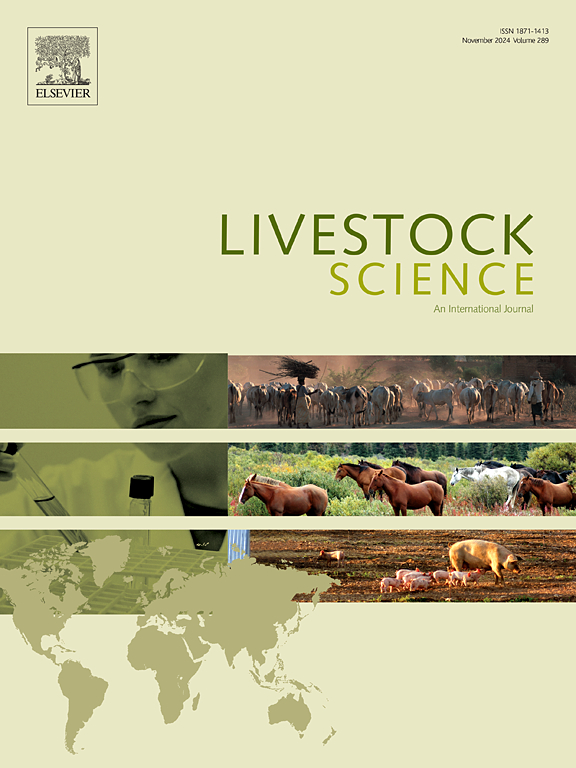Are mixed models more effective than linear models in predicting energy utilization for laying hens?
IF 1.9
3区 农林科学
Q2 AGRICULTURE, DAIRY & ANIMAL SCIENCE
引用次数: 0
Abstract
This study was conducted to develop mathematical models that can overcome the limitations of linear energy partitioning models in laying hens comparing the metabolizable and net energy bases. Three linear models and 2 nonlinear mixed-effect models were fitted to predict the energy utilization efficiency for body tissue deposition and egg production, as well as the maintenance requirements for metabolizable energy (MEm) and net energy (NEm). A total of 30 diets were individually formulated to achieve values below and above the nutritional recommendation of the genetic guidelines. Heat production and energy metabolism were measured in laying hens during the production phase using 6 open-circuit respiration chambers. Diets were randomly assigned into 5 groups, and each diet was replicated 4 times with 6 hens per replication. The experimental protocol included a 5-d adaptation to the experimental diets, 2-d chamber adaptation, 4-d measurements of gas exchange, total excreta collection and growth performance recording under feeding conditions, and 1-d gas exchange measurement under fasting conditions. Feed intake, body weight, egg production, egg mass, and excreta production were measured daily. The variables for total heat production (THP) and fasting heat production (FHP) were obtained through the Brouwer equation using VO2 and VCO2 measurements. Apparent metabolizable energy intake (AMEi) was determined by the difference between the gross energy intake and excreted. Retained energy (RE) was determined as the difference between AMEi and THP. Subsequently, the RE was partitioned between RE in body and egg. The RE in egg and body were partitioned into RE as protein and fat. Statistical analyses involved linear regressions and nonlinear mixed-effect regressions of the main variables described. The values obtained for MEm, NEm, and the efficiency of energy retention in body (kbody), and egg (kegg) in the linear models were 106 kcal/kg0.75.d, 90 kcal/kg0.75.d, 0.843, and 0,779, respectively. For nonlinear models the values were 94.15 kcal/kg0.75.d, 81.72 kcal/kg0.75.d, 0.463, and 0.638 for MEm, NEm, kbody and kegg, respectively. Nonlinear models were considered the ideal choice to determine MEm and NEm requirements due to the lowest error. The non-linear mixed model provides a more accurate representation of energy utilization in laying hens compared to linear models, offering a better characterization of energy partitioning within the net energy bases.
混合模型在预测蛋鸡能量利用方面是否比线性模型更有效?
本研究旨在建立能够克服线性能量分配模型在蛋鸡代谢能和净能基础比较中的局限性的数学模型。拟合3个线性模型和2个非线性混合效应模型,预测了蛋鸡对身体组织沉积和产蛋的能量利用效率,以及对代谢能(MEm)和净能(NEm)的维持需求。总共制定了30种饮食,以达到低于或高于遗传指南的营养建议值。采用6个开路呼吸室对蛋鸡产热和能量代谢进行了测定。试验随机分为5组,每种饲粮重复4次,每个重复6只鸡。试验方案包括试验饲粮的5 d适应、2 d舱室适应、饲养条件下4 d气体交换测量、总排泄物收集和生长性能记录、禁食条件下1 d气体交换测量。每天测定采食量、体重、产蛋量、产蛋量和排泄物产量。总产热(THP)和空腹产热(FHP)的变量通过使用VO2和VCO2测量的browwer方程得到。表观代谢能摄取量(AMEi)由总能量摄取量与排泄量之差决定。保留能(RE)为AMEi与THP之差。随后,稀土在体内和鸡蛋中进行分配。鸡蛋和机体中的RE被分解为蛋白质和脂肪。统计分析包括所描述的主要变量的线性回归和非线性混合效应回归。在线性模型中得到的MEm、NEm以及体和蛋的能量保留效率(kbody)为106 kcal/kg0.75。D, 90千卡/公斤0.75。D, 0.843, 0,779。对于非线性模型,该值为94.15 kcal/kg0.75。D, 81.72 kcal/kg0.75。MEm、NEm、kbody和kegg分别为0.463和0.638。由于误差最小,非线性模型被认为是确定MEm和NEm要求的理想选择。与线性模型相比,非线性混合模型能更准确地表征蛋鸡的能量利用,更好地表征净能量基内的能量分配。
本文章由计算机程序翻译,如有差异,请以英文原文为准。
求助全文
约1分钟内获得全文
求助全文
来源期刊

Livestock Science
农林科学-奶制品与动物科学
CiteScore
4.30
自引率
5.60%
发文量
237
审稿时长
3 months
期刊介绍:
Livestock Science promotes the sound development of the livestock sector by publishing original, peer-reviewed research and review articles covering all aspects of this broad field. The journal welcomes submissions on the avant-garde areas of animal genetics, breeding, growth, reproduction, nutrition, physiology, and behaviour in addition to genetic resources, welfare, ethics, health, management and production systems. The high-quality content of this journal reflects the truly international nature of this broad area of research.
 求助内容:
求助内容: 应助结果提醒方式:
应助结果提醒方式:


